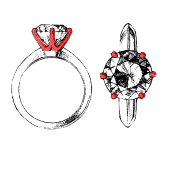| The Solitaire Ring |
 |
| In this edition |
 |
|
|
|
Autumn has arrived, and we are now headed straight towards Advent and the holiday season. In our industry, that means not only a lot of work, but also many interested and curious customers looking for that special Christmas gift.
This year, our autumn newsletter is dedicated to the Solitaire ring which takes on a whole new appeal with Natural Coloured Diamonds. The Solitaire remains the number one undisputed choice among the most popular engagement rings. Its sales today are actually one of the three key drivers of growth in the diamond industry.
For many people, the traditional Christmas holiday is the most important holiday of the year because of the strong focus on family and friends. Perhaps this is one of the reasons why marriage proposals and engagements increase during that season. Even without any wedding plans in view, however, the classic and timeless appearance of a Solitaire ring highlights the natural beauty of any wearer without stealing the show.
|
 |
|
|
The Origin of the Solitaire Ring
Contrary to common belief, the classic solitaire ring is actually a fairly recent tradition, beginning some 130 years ago. In 1886, Charles Lewis Tiffany designed a new ring, adorned with a 6-prong setting so that the diamond seemed to be floating on the wearer’s finger. Although similar designs in which an eagle’s claw “grasped” the stone can be found as early as the Middle Ages, the prong setting only really became popular with Charles Lewis Tiffany’s ring design. Before that, it was much more common to set diamonds low against the precious metal band, thus preventing the diamond’s sparkle and fire from shining though.
Tiffany’s idea was to highlight the diamond in a whole new way. Light could now come at the stone from all sides, allowing all of its beauty and elegance to unfold. The original project shows a colourless, brilliant cut diamond set in 6 prongs and mounted on a simple, delicate band. The French word for loner, “solitaire”, gave the solitaire ring its name.
|
 |
From that original model, multiple creations have since evolved and it is no longer necessary for a solitaire to be set with a round diamond. Thanks to the great wealth of cuts and colours found in Natural Coloured Diamonds, a classic solitaire ring can become a unique and individual piece of jewellery because just about any diamond will become an eye-catcher when set as a solitaire.
This diversity means real options for any budget, as even a 0.10 ct stone can produce a beautiful effect. Two or three carat stones are, of course, also ideally suited. Imagination and creativity know no limits.
|
|
Any ring that is set with one single stone is considered a Solitaire ring.

1. Bezel Setting
The sides of the diamond are surrounded by a slightly overlapping metal band.
Our advice: As the lower part of the diamond is covered and less light can be absorbed, the stone will appear darker and have less brilliance. Closed settings are therefore more suitable for lighter coloured diamonds.
Black diamonds, whose brilliance comes from the lustre of the stone’s surface, are also very well suited to bezel settings as black diamonds are opaque and only need light from above to set off their brilliance. In addition, they are relatively brittle and a bezel setting provides protection from the possible knocks and blows of everyday life.
2. Prong Setting
The diamond is held by three to six prongs, grasping the stone like a claw.
Our advice: Even dark colours like, for example, C7 or Fancy Deep Brownish Orange are enhanced by this setting. Since the diamond is only held by thin metal wires, maximum light exposure allows the stone’s full brilliance to unfold.
Natural Coloured Diamonds are not usually cut as brilliants because the round brilliant cut was designed to show as little colour as possible. Other cuts like oval, pear, princess, marquis or cushion are more common and hold colour better while at the same time adding more intensity. Prong settings can be adapted to almost any cut.
3. Channel Setting
In this setting, the diamond is secured in place between two vertical strips of precious metal.
Our advice: Thanks to the ample light from both sides, the channel setting also works well for medium to dark colours. Distinctive cuts such as princess or baguette are enhanced by this clean and streamlined setting.
4. Tension Setting
The tension setting is a very modern twist in design. The diamond is held in place solely by the inherent tension of the ring.
Our advice: In general, all colours are suitable for a tension setting because the stone can absorb light from all sides. Care should be taken, however, to choose only stones with good clarity, although inclusions in intense colours may not be immediately visible. Indeed, diamonds with larger inclusions or natural cracks might not be able to withstand the pressure from the metal and shatter. For this reason, black diamonds are not suitable for tension settings.
|
|
1. Brilliant / Fancy Grayish Pink Brown / 0,36 ct / VS / 4,49 x 4,51 x 2,80 mm
2. Brilliant / Fancy Deep Olive Green / 0,33ct / VS / 4,35 - 4,36 x 2,74 mm
3. Princess / C2 / 0.52 ct / VVS / 4,61 x 4,60 x 3,01 mm
1. Brilliant / Fancy Deep Yellow Orange / 0.41 ct / SI / 4,60 - 4,65 x 2,97 mm
2. Radiant / Fancy Vivid Orangy Yellow / 0.50 ct / SI2 / 5,51 x 3,57 x 2,78 mm / GIA
3. Cushion / Fancy Intense Yellow / 0.71 ct / SI1 / 5,84 x 4,55 x 3,01 mm / GIA |
|
1. Cushion / C4 / 0.49 ct / VVS / 4,72 x 4,48 x 3,11 mm
2. Radiant Square / Fancy Pink Purple / 0.52 ct / VS2 / 4,37 x 4,34 x 3,20 mm / GIA
3. Cushion / Fancy Yellow / 2.34 ct / VS1 / 7,56 x 6,75 x 4,92 mm / GIA |
|
|
